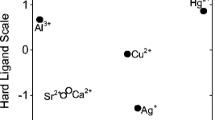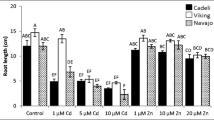Abstract
Two-day-old maize (Zea mays L.) seedlings were incubated on the solutions of Ag, Cd, Pb, Zn, Cu, Tl, Co, and Hg salts (0.001 to 3 g/l). Toxicity of heavy metals was assessed as the inhibition of root growth on the first, second, and third days, the change in the length of the lateral root zone, and the duration of lateral root development from the first division in pericycle to emergence. For all salts under study, the ratio of the lethal concentration to the lowest concentration slowing down root growth was about ten, and growth inhibition was not almost enhanced in the course of three days. With concentrations calculated as g/l, metal toxicity declined in the following order: Cu ≈ Tl > Ag > Cd > Hg > Co > Zn > Pb; for molar concentrations, the order was the following: Tl3+ > Cu2+ > > Ag+ > Hg2+ ≈ Cd2+ > Zn2+ ≈ Pb2+ ≈ Co2+. Duration of lateral root development was least affected by heavy metals. Metal affinity of biological compounds for SH-groups was closely correlated (r = 0.9) with the molar concentration that inhibited primary root growth by 50%. Because of the narrow range of effective concentrations, only slightly increasing inhibition over the exposure time, tolerant root branching, and close relationship between the toxicity and the constant of binding to SH-groups, we conclude that the salts under study exert nonselective inhibition and root growth is slowed down due to the general toxicity of heavy metals rather than selective inhibition of any particular process or processes.
Similar content being viewed by others
REFERENCES
Ivanov, V.B., Root Growth Responses to Chemicals, Sov. Sci. Rev., Ser. D, 1994, pp. 1-70.
Levina, E.N., Obshchaya toksikologiya metallov (General Toxicology of Metal), Leningrad: Meditsyna, 1972.
Wang, W., Root Elongation Method for Toxicity Testing of Organic and Inorganic Pollutants, Environ. Toxicol. Chem., 1987, vol. 6, pp. 409–414.
Breckle, S.-W., Growth under Stress: Heavy Metals, Plant Roots: The Hidden Half, Waisel, Y. and Kafkafi, U., Eds., New York: Marcel Dekker, 1991, pp. 351–373.
Hagemeyer, J. and Breckle, S.-W., Growth under Trace Element Stress, Plant Roots: The Hidden Half, Waisel, Y. and Kafkafi, U., Eds., New York: Marcel Dekker, 1996, pp. 415–433.
Willkins, D.A., The Measurement of Tolerance to Edaphic Factors by Means of Root Growth, New Phytol., 1978, vol. 86, pp. 623–633.
Ivanov, V.B., Bystrova, E.I., Dubrovsky, J.G., and Ploshinskaya, M.E., Duration of Lateral Root Formation in Maize Seedlings as Effected by Diverse Factors, Root Demographics and Their Efficiencies in Sustainable Agriculture, Grasslands and Forest Ecosystems, Box, J.E., Ed., Dordrecht: Kluwer, 1998, pp. 777–787.
Metal Ions in Biological Systems, Concept on Metal Ion Toxicity, Singel, H. and Singel, A., Eds., New York: Marcel Dekker, 1986, vol. 20. Translated under the title Nekotorye voprosy toksichnosti ionov metallov, Moscow: Mir, 1993.
Seregin, I.V. and Ivanov, V.B., Cadmium and Lead Distribution and Their Toxic Effects on Maize Roots, Plant under Environmental Stress. Int. Symp., Moscow, 2001, pp. 255-256.
Neiboer, E. and Richardson, D.H.S., The Replacement of the Non-Descriptive Term “Heavy Metals” by a Biologically and Chemically Significant Classification of Metal Ions, Environ. Pollut., 1980, vol. 1, pp. 3–26.
Wong, M.H. and Bradshaw, A.D., A Comparison of the Toxicity of Heavy Metals Using Root Elongation of Rye Grass, Lolium perenne, New Phytol., 1982, vol. 91, pp. 255–261.
Karataglis, S., Estimation of the Toxicity of Different Metals Using as Criterion the Degree of Root Elongation in Triticum aestivum Seedlings, Phyton, 1987, vol. 26, pp. 209–217.
Ernst, W.H.O., Vercleij, J.A.C., and Schat, H., Metal Tolerance in Plants, Acta Bot. Neerl., 1992, vol. 43, pp. 229–248.
Ernst, W.H.O., Effects of Heavy Metals in Plants at the Cellular and Organismic Level, Ecotoxicology, Ecological Fundamentals, Chemical Exposure and Biological Effects, Schuurman, G. and Markert, B., Eds., Heidelberg: Wiley, 1998, pp. 587–620.
Seregin, I.V. and Ivanov, V.B., Physiological Aspects of Cadmium and Lead Toxic Effects on the Higher Plants, Fiziol. Rast. (Moscow), 2001, vol. 48, pp. 606–630 (Russ. J. Plant Physiol., Engl. Transl.).
Nichols, R. and Frost, C.E., Post-Harvest Effects of Ethylene on Ornamental Plants, Ethylene and Plant Development, Roberts, J.A. and Turker, G.A., Eds., London: Butterworths, 1985, pp. 343–351.
Ivanov, V.B., Bystrova, E.I., Obroucheva, N.V., Antipova, O.V., Sobotik, M., and Bergmann, H., Growth Response of Barley Roots as an Indicator of Lead Toxic Effects, Angew. Bot., 1998, vol. 72, pp. 140–143.
Arduini, I., Godbold, D.L., and Onnis, A., Cadmium and Copper Change Root Growth and Morphology of Pinus pinea and Pinus pinaster Seedlings, Physiol. Plant., 1994, vol. 92, pp. 675–680.
Breckle, S.-W., Growth of Tree Roots under Heavy Metal (Pb-) Stress, Acta Phytogeogr. Suec., 1996, vol. 81, pp. 39–43.
Nesterova, A.N., Effects of Lead, Cadmium, and Zinc Ions on the Meristem Organization and Growth of Maize Seedlings, Cand. Sci. (Biol.) Dissertation, Moscow: Moscow State Univ., 1989.
Obroucheva, N.V., Bystrova, E.I., Ivanov, V.B., Antipova, O.V., and Seregin, I.V., Root Growth Responses to Lead in Young Maize Seedlings, Plant Soil, 1998, vol. 200, pp. 55–61.
Lane, S.D., Martin, E.S., and Garrod, J.P., Lead Toxicity Effect on Indole-3-Acetic Acid-Induced Cell Elongation, Planta, 1978, vol. 144, pp. 79–84.
Burzynski, M. and Jacob, M., Influence of Lead on Auxin-Induced Cell Elongation, Acta Soc. Bot. Pol., 1983, vol. 52, pp. 231–239.
Barcelo, J., Poschenrieder, Ch., Andren, I., and Gunse, B., Cadmium Induced Decrease of Water Stress Resistance in Bush Bean Plants (Phaseolus vulgaris, cv. Contender), Plant Physiol., 1986, vol. 125, pp. 17–25.
Author information
Authors and Affiliations
Rights and permissions
About this article
Cite this article
Ivanov, V.B., Bystrova, E.I. & Seregin, I.V. Comparative Impacts of Heavy Metals on Root Growth as Related to Their Specificity and Selectivity. Russian Journal of Plant Physiology 50, 398–406 (2003). https://doi.org/10.1023/A:1023838707715
Issue Date:
DOI: https://doi.org/10.1023/A:1023838707715




